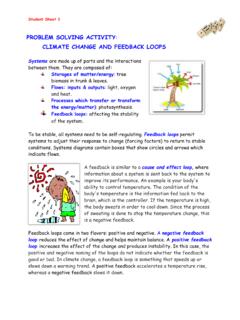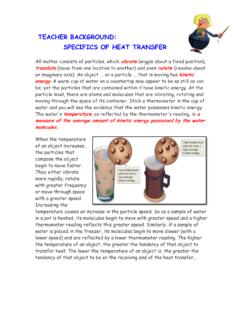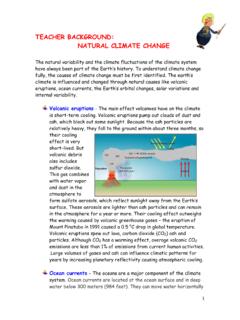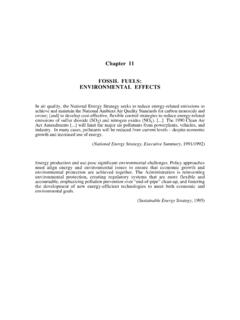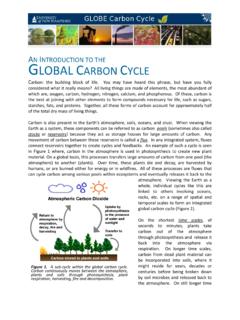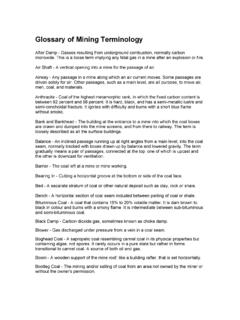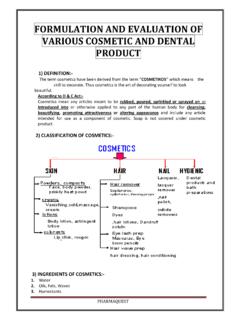Transcription of CRITICAL THINKING ACTIVITY: THE METHANE CYCLE
1 Student Sheet 1. CRITICAL THINKING ACTIVITY: THE METHANE CYCLE . WHAT IS METHANE ? METHANE is a chemical compound with the molecular formula CH4. It is the main component in natural gas. METHANE is considered the simplest of alkanes, compounds that consist only of hydrogen (H) and carbon (C) elements. METHANE is an odorless, colorless, tasteless gas that is lighter than air. When METHANE burns in the air it has a blue flame. In sufficient amounts of oxygen, METHANE burns to give off carbon dioxide (CO2) and water (H2O). When it undergoes combustion it produces a great amount of heat, which makes it very useful as a fuel source. METHANE AS A GREENHOUSE GAS. METHANE is a very effective greenhouse gas. While its atmospheric concentration is much less than that of carbon dioxide , METHANE is 28 times more effective (averaged over 100 years) at trapping infrared radiation.
2 The atmospheric residence time of METHANE is approximately 9 years. Residence time is the average time it takes for a molecule to be removed from the atmosphere. In this case, every molecule of METHANE that goes into the atmosphere remains there for 8 years until it is removed by oxidization into carbon dioxide (CO2) and water (H2O). It is difficult to quantify METHANE emissions since sources are spread out over large areas and emission values are small and variable in time and space. Student Sheet 2. It is estimated that up to 60% of the current METHANE flux from land to the atmosphere is the result of human activities. Some of these activities include emissions from fermentation processes associated with livestock, from cultivated rice paddies, from fossil fuel use and biomass burning, and from landfills. METHANE concentrations have been increasing steadily for the past 200.
3 Years, and despite a decline from 1983-2006, it increased again in this time period, atmospheric METHANE concentrations have more than doubled. As with CO2, human activity is increasing the CH4. concentration faster than natural sinks can offset it. Future trends are particularly difficult to anticipate, partly due to an incomplete understanding of the climate feedbacks related to CH4 emissions. It is also difficult to predict how, as human populations grow, possible changes in livestock raising, rice cultivation, and energy utilization will influence CH4 emissions. Student Sheet 3. THE METHANE CYCLE . This diagram of the METHANE CYCLE illustrates the flow of METHANE from sources into the atmosphere, as well as the sinks that consume METHANE Most people have heard of the water CYCLE , in which water evaporates into the air, returns to Earth and then evaporates again.
4 Many other substances, including METHANE , CYCLE this way too. There are many sources that release METHANE (CH4) into the atmosphere. There are also sinks or ways that METHANE is trapped or destroyed. The METHANE CYCLE begins in the soil where METHANE gas is created by microbes. Soil METHANE is consumed by methanotrophs, microorganisms that feed on METHANE . Methanogens make more METHANE that methanotrophs consume. Methanotrophs live in drier soil layers above the deep, wet oxygen poor soils of swamps. Their food bubbles past them on its way to the surface, releasing METHANE into the atmosphere. This METHANE joins METHANE from other sources, such as landfills, livestock and exploitation of fossil fuels. Student Sheet 4. The main mechanism for removal of METHANE from the earth's atmosphere is oxidation within the OH H troposphere by the hydroxyl radical (OH).
5 A. hydroxyl radical is a negatively charged oxygen atom bonded to a hydrogen atom (OH). Hydroxyl radicals are a form of sink because they scrub . the atmosphere clean of pollutant molecules and break them down. For this reason OH is known as the cleanser of the atmosphere'. After reacting with OH, atmospheric METHANE is converted to CO2 by a long series of chemical reactions.) Some of the METHANE present in the troposphere passes into the stratosphere where the same process scrubs the atmosphere clean of METHANE there. In an ideal world, METHANE sources would be balanced with METHANE sinks, as with CO2, however, global atmospheric METHANE concentrations are rising as a result human activities. Scientists are worried because as the planet warms, even more METHANE will to be released from soils or other places adding to the global warming problem.
6 METHANE crystals called clathrates form in cold, oxygen poor undersea sediments. Clathrates are also trapped in permafrost, the permanently frozen soil in the arctic and subarctic latitudes. Clathrate ice, also called METHANE hydrate, is solid and white, similar to water ice. However, this ice consists of water molecules that are frozen around molecules of METHANE . Clathrate deposits were once sinks where METHANE was isolated. However, as the planet warms, some of these deep, cold sediments are melting, sending METHANE bubbling to the surface. Because CH4 is a greenhouse gas, it traps heat in the atmosphere and warms the planet more. Student Sheet 5. NATURAL SOURCES. Natural sources of METHANE include wetlands, gas hydrates, termites, oceans, freshwater bodies and other sources such as wildfires. WETLANDS. Natural wetlands are responsible for approximately 80% of global METHANE emissions from natural sources.
7 Wetlands, such as bogs, marshes, fens and permafrost provide a habitat favorable to microbes that produce METHANE during the decomposition of organic material. These microbes require environments with no oxygen and plentiful organic matter, both of which are present in wetland conditions. Wetlands contribute approximately 140-280 Tg (million metric tons) to the global METHANE budget each year. TERMITES. Global METHANE emissions from termites and their mounds are estimated to be about 11% of the global METHANE emissions from natural sources or about 2-20 Tg per year. Microbes in the guts of termites produce METHANE as part of their normal digestive process, and the amount generated varies among different species. The emissions contributed by termites depend largely on the population of these insects, which varies significantly in different regions.
8 Student Sheet 6. OCEANS. Oceans are estimated to be responsible for about 8% of the global METHANE emissions from natural sources or between 20- 30 Tg yearly. The source of METHANE from oceans is not entirely clear, but two identified sources include the anaerobic (oxygen-free) digestion in marine zooplankton and fish, and also from METHANE produced in sediments and drainage areas along coastal regions. METHANE HYDRATES. Global emissions from METHANE hydrates accounts for approximately 5% of the global METHANE emissions from natural sources. METHANE hydrates are molecules of METHANE that are frozen into ice crystals. We're not sure exactly how much METHANE is trapped in methyl hydrates, or how much is in danger of escaping. Overall, the amount of METHANE stored in these hydrates globally is estimated to be very large, making the potential for the release of large quantities of METHANE a real possibility if serious breakdowns in the stability of the deposits were to occur.
9 Student Sheet 7. HUMAN SOURCES. Human activities that produce METHANE include fossil fuel production, the livestock industry, rice cultivation, biomass burning, and waste management. These activities release significant quantities of METHANE to the atmosphere. LANDFILLS. METHANE is generated in landfills and open dumps as waste decomposes under anaerobic conditions (oxygen-free). The amount of METHANE created depends on the quantity and moisture content of the waste and the design and management practices at the site. Landfills in regions with dry conditions are not as productive as those in area with high moisture content. In 2012, landfills contributed Tg of METHANE to the atmosphere. FOSSIL FUELS. Fossil fuels are formed by natural processes such as anaerobic decomposition of buried dead organisms. Fossil fuels contain high percentages of carbon and include coal, petroleum, and natural gas.
10 Student Sheet 8. METHANE is the primary component of natural gas. METHANE is released during the production, processing, storage, transmission, and distribution of natural gas. Because natural gas is often found with oil, the collection and combustion of oil also contributes to the total METHANE emissions. In addition, METHANE trapped in coal deposits is released during normal mining operations in both underground and surface mines. According to the 2013. IPCC Report, the combined retrieval and use of fossil fuels contributed approximately 85-100 Tg of METHANE to the atmosphere. LIVESTOCK. Domesticated livestock such as cattle, buffalo, sheep, goats, and camels produce large amounts of METHANE as part of their normal digestive processes. In the large, first stomach of these animals, microbial fermentation converts feed into products that can be digested and utilized by the animal.


